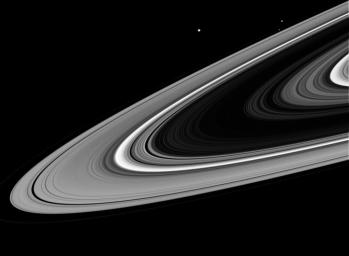
|
From the Dark Side
- Click the image above for a larger view
- Full-Res JPEG (1021 x 750) (48.9 kB)
- Full-Res TIFF (1021 x 750) (356.9 kB)
Caption:
As Cassini swung around to the dark side of the planet during its first close passage after orbit insertion, the intrepid spacecraft spied three ring moons whizzing around the planet.
Visible in this image are: Mimas (398 kilometers, or 247 miles across) brightest and above center; Janus (181 kilometers, or 112 miles across) second brightest at upper left; and Prometheus (102 kilometers, or 63 miles across) just above the main rings at upper left.
The normally bright B ring appears very dark from this vantage point. Regions with smaller concentrations of particles, such as the Cassini division (bright near center) transmit more sunlight and thus are brighter.
The image was taken in visible light with the Cassini spacecraft wide angle camera on Oct. 27, 2004, at a distance of 757,000 kilometers (470,000miles) from Saturn. The image scale is about 42 kilometers (26 miles) per pixel.
Background Info:
The Cassini-Huygens mission is a cooperative project of NASA, the European Space Agency and the Italian Space Agency. The Jet Propulsion Laboratory, a division of the California Institute of Technology in Pasadena, manages the Cassini-Huygens mission for NASA's Office of Space Science, Washington, D.C. The Cassini orbiter and its two onboard cameras, were designed, developed and assembled at JPL. The imaging team is based at the Space Science Institute, Boulder, Colo.
For more information, about the Cassini-Huygens mission visit, http://saturn.jpl.nasa.gov and the Cassini imaging team home page, http://ciclops.org .
Cataloging Keywords:
| Name | Value | Additional Values |
|---|---|---|
| Target | Saturn | B Ring, Cassini Division, Janus, Mimas, Prometheus, Saturn Rings |
| System | Saturn | |
| Target Type | Planet | Gap, Ring, Satellite |
| Mission | Cassini-Huygens | |
| Instrument Host | Cassini Orbiter | |
| Host Type | Orbiter | |
| Instrument | Imaging Science Subsystem (ISS) | |
| Detector | Wide Angle Camera | |
| Extra Keywords | Grayscale, Visual | |
| Acquisition Date | ||
| Release Date | 2004-12-10 | |
| Date in Caption | 2004-10-27 | |
| Image Credit | NASA/JPL/Space Science Institute | |
| Source | photojournal.jpl.nasa.gov/catalog/PIA06529 | |
| Identifier | PIA06529 | |
